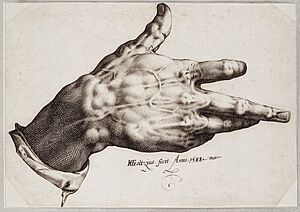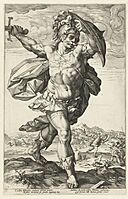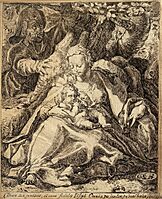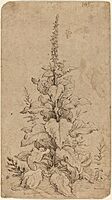Hendrick Goltzius facts for kids
Quick facts for kids
Hendrick Goltzius
|
|
|---|---|

Self-portrait (c. 1593–94)
|
|
| Born |
Hendrick Goltz
January/February 1558 Bracht, Duchy of Jülich, Holy Roman Empire
|
| Died | 1 January 1617 (aged 58–59) |
| Occupation | Printmaker, draftsman, painter |
| Known for | Use of the burin tool for engraving |
| Style | Northern Mannerism |
Hendrick Goltzius (born January or February 1558 – died January 1, 1617) was a famous Dutch artist. He was born in Germany. He was known for making prints, drawings, and paintings.
Goltzius was one of the best engravers in the Netherlands during the early Baroque period. This was a time when art became very dramatic and lively. People admired his amazing skills and the exciting way he put his art together.
One art expert, A. Hyatt Mayor, said that Goltzius was the last great engraver who could draw like a skilled painter. He also created many pictures for others to copy. Later in his life, Goltzius also started to paint.
About Hendrick Goltzius

Hendrick Goltzius was born in a village called Bracht, which is now part of Germany. When he was three years old, his family moved to Duisburg.
He first learned to paint on glass from his father. Then, he learned how to engrave from a Dutch scholar named Dirck Volckertszoon Coornhert. Coornhert knew a lot about many different subjects.
In 1577, Goltzius moved with Coornhert to Haarlem in the Netherlands. He lived and worked there for the rest of his life. In Haarlem, he also worked for Philip Galle, making a series of prints about the story of Lucretia.
When Goltzius was a baby, his right hand was injured in a fire. It was not shaped normally. However, this turned out to be helpful for holding the burin, which is a tool used for engraving. Because of his hand, he learned to draw using the strong muscles of his arm and shoulder. This helped him create powerful and flowing lines in his art.
In the 1580s, Goltzius and his friends, Karel van Mander and Cornelis van Haarlem, started an art school in Haarlem. They wanted it to be like the art schools in France and Italy. At their school, artists could study the human body and talk about art ideas.
When Goltzius was 21, he married a woman who was about eight or nine years older than him. Her money helped him start his own art business in Haarlem. However, his marriage was not a happy one.
Goltzius felt that his unhappy home life was making him sick. So, in 1590, he decided to travel through Germany to Italy. While in Italy, he was very impressed by the artworks of Michelangelo.
He returned to Haarlem in August 1591, feeling much better. He continued to work there until he passed away.
Goltzius was very skilled at making portraits, even small ones. They showed great detail and captured the unique look of each person. His life-size self-portrait is a great example of his larger works.
Goltzius became very good at a technique called the "swelling line." This is where he made lines thicker or thinner using his engraving tool. This created a sense of light and shadow from a distance.
He also helped develop the "dot and lozenge" technique. This involved placing small dots inside diamond-shaped spaces made by crisscrossing lines. This helped him create even more detailed shading in his prints.
Experts say Goltzius created 388 of his own prints. Another 574 prints were made by other artists based on his designs.
Many people say Goltzius was as good as Albrecht Dürer, another famous artist, when it came to using the burin. Goltzius made engravings of paintings by Bartholomeus Spranger, which made both artists more famous.
Goltzius started painting when he was 42 years old. Some of his paintings can be seen in Vienna. He also made a few chiaroscuro woodcuts, which are prints made from wood blocks using different shades of color. He was the stepfather of another engraver named Jacob Matham. Goltzius died in Haarlem at the age of 58.
Where to See His Art
Many large art museums and print rooms around the world have collections of Goltzius's engravings. Some of these places include:
- Museum Boijmans Van Beuningen, Rotterdam
- Rijksmuseum Amsterdam
- Blanton Museum of Art, Austin
- University of Michigan Museum of Art, Ann Arbor
- The Metropolitan Museum of Art, New York City
- Philadelphia Museum of Art
- British Museum, London
- Los Angeles County Museum of Art
- Fine Arts Museums of San Francisco
Gallery
-
Portrait of the Shell Collector Jan Govertsen van der Aer, 1603, Museum Boijmans Van Beuningen
See also
 In Spanish: Hendrick Goltzius para niños
In Spanish: Hendrick Goltzius para niños






